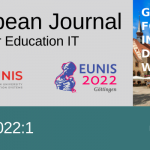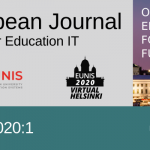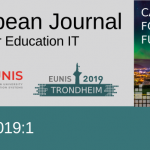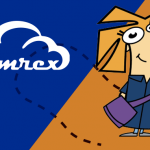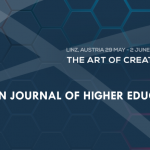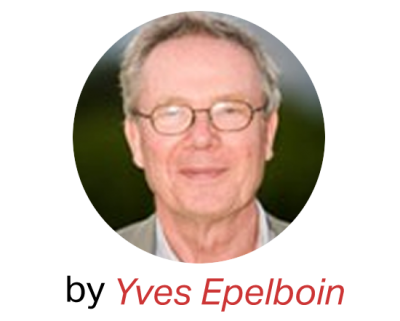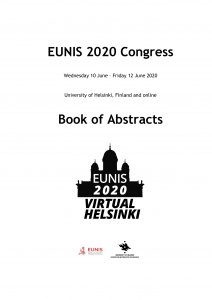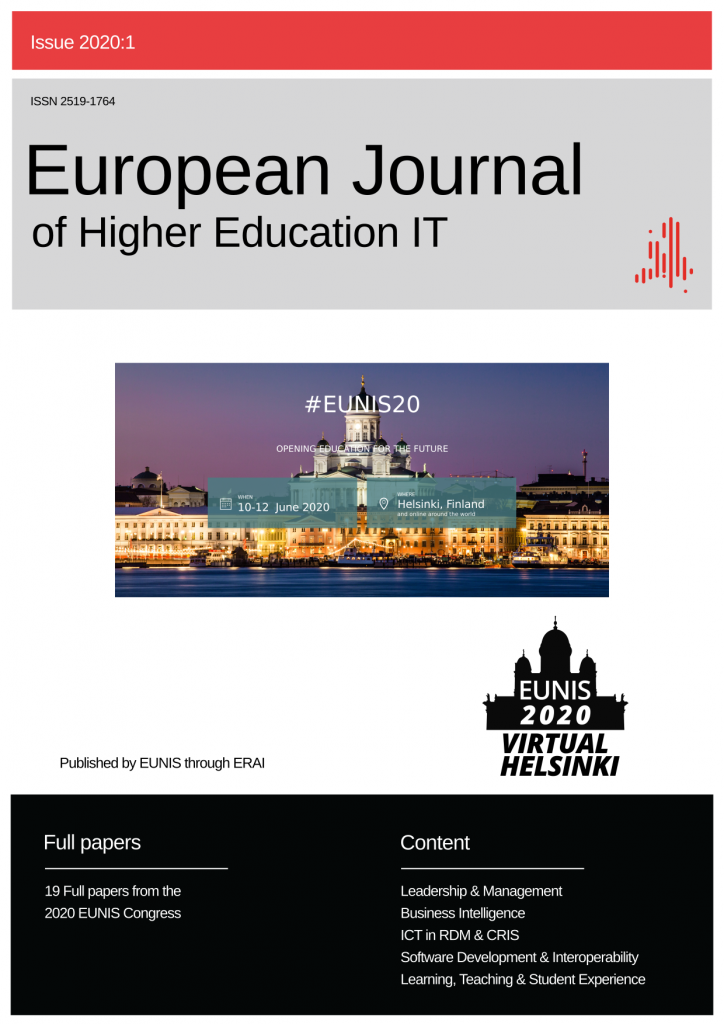
Reference to articles in this issue should be made as follows: name of author(s). title, European Journal of Higher Education IT 2020-1, EUNIS
European Journal of Higher Education IT – EJHEIT
This issue of the European Journal of Higher Education IT (2020/1) consists of a selection of the full papers from the EUNIS 2020 congress.
A total of 82 papers were submitted to the congress, 19 of which are published here.
In this issue there are a variety of themes in the tracks “Leadership & management” to “Learning, teaching & student experience”
European Journal of Higher Education IT is a journal created to support the mission of EUNIS and to disseminate International Research within the field of higher education IT. Please also refer to the Editorial Committee.
ISSN 2519-1764
Leadership & management
A transitional plan for digital and technology change
Jim Nottingham, Paula Nottingham
Abstract
This is a challenging time for universities in a global context as they seek to fully harness the potential of being digital and teaching digitally. Over the last five years the University of the Arts London (UAL) has been on a transformative digital journey. UAL is an art based institution consisting of six world class (World University Rankings, 2020) colleges on 18 sites across an international city and a
constituency of users that total over sixty thousand.
Since 2015 UAL has been moving towards a more defined governance structure for IT and Digital services, this has largely been developed by working collaboratively with the Colleges and Professional Services. It has become a significant strategic driver that UAL engages in a more strategic approach to the use of digital technology across its wide spectrum of activities. This paper presents a case study of how UAL arrived at its current transitional IT plan that promotes digital transformation.
UAL seeks to fully harness the potential of being digital to advance how we manage our digital services and how we think about the potential to leverage the digital landscape to advance UAL’s mission and
values. This approach has to include both Learning and Teaching and operational rationalisation. In order to best position UAL for the next three years of growth and success it is essential that this Digital and IT strategy is fully endorsed and fully supported. Over the last twelve months a transitional plan has been developed to enable a transition towards a fully developed IT & digital strategy.
The transitional plan sets out how to prepare for the next mid-term UAL strategy through greater business efficiency in the technology function, ensuring IT plays an enabling role in Learning and Teaching, Research and Knowledge Exchange. This plan has involved a necessary segmentation of approach across UAL which has followed the steps of Digitisation, Digitalisation and Digital Transformation (Andersen, 2018) to advance how we manage our UAL wide digital services and governance.
Cultural Change in Digital Transformation within Higher Education
Pekka Kähkipuro
Abstract
The role of information technology within higher education is changing radically with the progress of digital transformation. This implies significant changes in several areas. The focus has typically been in business change, in processes, and in modern digital technology. However, cultural aspects have recently been identified as the most important road blocker for organisations to take digital transformation forward. We have also seen how significant external events, such as the Covid-19 pandemic, can accelerate and redirect change at the cultural level.
This paper investigates the required cultural changes for digital transformation in the context of Higher Education. Firstly, we identify seven cultural elements that need to be addressed to cope with the change. Secondly, we provide a template that allows institutions to find the best approach for managing cultural change when introducing digital technologies. The template consists of four key areas: (1) reviewing the vision and the strategy, (2) managing change proactively and continuously, (3) navigating your way in the changing landscape, and (4) solving issues on the spot.
Maximising benefits from ICT in Federated/Hybrid organisation models and balancing the roles of CIO & CPO function in Higher Education
Ravi Prakash, Pekka Kähkipuro
Abstract
The objective of the paper is to share a simple governance framework to discuss the skills, competencies and structures required to meet the demands of federated and hybrid ICT models. There are multiple ways in which ICT organisations can seek to provide value to the business. The paper shows four different types of ICT organisation models driven by the complexity of business and ICT’s role. For each model, efficiencies and business value is typically sought after with different approaches, such as driving standardisation, managing business complexity, or enhancing the agility of IT. The paper also illustrates example structures for ICT for demonstrating the differences between the common models – Centralised, Federated, Hybrid. The second part of the paper dives deeper into how commercial benefits are driven for different ICT organisation models. Higher education institutions with their complex business structure provide an example for the federated and hybrid models.
Survey on the Status of Digitization at German HEI
Harald Gilch, Anna Sophie Beise, René Krempkow, Marko Müller, Friedrich Stratmann, Klaus Wannemacher
Abstract
The results of a survey on the digitization of universities in Germany prove that digitization is of great importance for the three dimensions of research, teaching and learning and administration in general, but that the actual implementation status of digitization at German universities is much more restrained. Particularly in the area of administration, the actual level of digitization accomplished at German universities is still regarded as comparatively low. If the IT infrastructures and the systems implemented are analyzed, the status quo is characterized by a large amount of different systems, most of which do not yet allow continuous workflows and are hardly integrated. Many universities show completely different levels of maturity for different systems.
Business Intelligence
Digitalizing Teaching Processes – How to Create Usable Data with Minimal Effort
Raine Kauppinen, Altti Lagstedt, Juha Lindstedt
Abstract
Having enough timely and correct data is essential for decision making, and information systems (IS) are largely used to collect that data. However, the traditional form-based solutions do not always produce adequate data. Instead, since the systems do not support data collection in users’ daily actions, they cause extra work, that may or may not be done depending, for example, on the users’ workload. This applies especially in education processes where wrongly designed IS not only causes extra work, but also reduces the autonomy of experts (teachers). This easily leads into the situation where an IS is not used, or it is used only ostensibly to fulfill the given orders. Either way, the data collected is not reliable. In addition, situation like this gives rise to informal procedures and practices: the official and practical ways do not match, and in practical way, no or little data is collected. Since the quality of data collection is emphasized especially in AI-based decision making, and since the process digitalization is affecting education processes as well, we see it important to find out how education processes should be digitalized in order to get timely data with good quality and coverage. Regarding this, we studied and participated on thesis management system development in Haaga-Helia University of Applied Sciences, collected findings and formulated main fundamentals on creating usable data with minimal effort when digitalizing teaching process based on our findings.
The Transfer Dashboard: Integrating the Third Mission into the University Infrastructure
Jan Bernoth, Ulrike Lucke
Abstract
The goal of this paper is to introduce aspects of transfer (the third mission) into the digital infrastructure of a higher education institution (HEI). While there is little visibility of transfer characteristics in discussions on digital infrastructure, the political importance of this topic is growing. Therefore, our approach is to extend the infrastructure of HEIs with features from modern data analytics. We identified sources relevant for transfer and visualize them in a dashboard. As a first step, we designed descriptive or diagnostic components for the different fields of transfer. Building on this, next steps towards predictive components are discussed.
Results of the 2020 ZKI IT Top Trends Survey in Germany
Malte Dreyer
Abstract
The Working Group Strategy and Organisation of the German ZKI Association conducts an annual survey on the most important topics and focal points of the member institutions. For the year 2020, the survey was extended with an additional catalogue of questions on the focus “digitisation”. In 2020, it covers the responses from 66 German universities, applied universities and research organisations for the 23 questions on topics such as management trends, compliance requirements, governance, technical endeavors and skills. The ZKI IT Top Trends Survey 2020 shows a shift of emphasis within the IT centers from rather technical topics to management, communication and digitization aspects. The paper is presenting the results with a focus on digitisation, IT governance and is also presenting examples from the management questions.
ICT in RDM & CRIS ICT
How to Manage IT Resources in Research Projects? Towards a Collaborative Scientific Integration Environment
Marius Politze, Florian Claus, Bela Brenger, M. Amin Yazdi, Benedikt Heinrichs, Annett Schwarz
Abstract
With CoScInE, the Collaborative Scientific Integration Environment, we present a software platform to allocate and manage IT resources in research projects. While the platform itself does not store any research data, it enables integration of multiple storage resources and allows metadata management across these resources. This supports researchers in curating their research data and complying with principles to safeguard good scientific practice such as findability, accessibility and reusability. Additionally, operators of central IT infrastructures can benefit from resource allocation management and usage monitoring while complying with established scientific and economic standards.
Why data services should be invisible. A coordinated approach across universities
Thomas Eifert, Denise Thomas Eifert, Denise Dittrich, Julia Opgen-Rhein
Abstract
“Digitalisation” is a ubiquitous theme at every university. Since by now literally all aspects of university work and life depend on IT and, in particular, on data, the availability and persistence of data and data services is essential. As trivial as this appears, scientific users need to rely on the availability of their data and data stores, either for using previously stored data or to run experiments that generate new data. This includes all aspects, from the availability to persistency.
Since in many cases access to the data happens in a tiered IT setup, there is no way of “direct” access to the data but a suitable – often server-based – software stack has to be up and running as well. Plus, it’s not “a” software stack but a vast multitude. Therefore, the mentioned requirements go beyond bitstream preservation but include the infrastructure to access the information.
In addition, the justified expectation of all users is an (almost) 24×7-availability of services, and, in particular, an assured persistency of once-stored data. So, data services have to be invisible in the sense that they are expected to be ubiquitously and continuously available. Any “visibility” can be regarded as a disturbance of this expectation.
To cope with this combination of amounts of data, level of expectation, and technical multitude and a concurrent steady growth in all of these dimensions, a consortium of universities in North-Rhine Westphalia currently runs a project to develop structures for joint, university-spanning services for safe data storage and high storage and server availability.
(Recipient of the EUNIS Best Paper Award)
The Processes Behind Research Data Management
Ville Tenhunen, James A.J. Wilson
Abstract
Without understanding the need for compatibility between research data management systems and research processes, it is not possible to design and develop efficient and user-friendly data services for researchers. In this paper we describe the research data processes behind RDM lifecycles and provide an insight into the actual implementations of these services all around the world in different research systems.
Software Development & Interoperability
Citizen Developers Driving the Digital Campus
Christoph Baumgarten, Alex Simeon, Michael C. Wilhelm
Abstract
What could a university look like that has successfully entered the digital age? This question has been intensively discussed at three Swiss universities of applied sciences, which are currently in a merger process. The result is a holistic architecture for a digital campus that not only covers infrastructural aspects, but also contains content-, skills-, management- and culture-related building blocks for a comprehensively digitalized university.
The deliberate active involvement of campus citizens as so-called citizen developers by guiding and supporting their hands-on participation in the university’s digital transformation efforts is identified as an important leverage for implementing the digital campus and illustrated by an example.
Designing an academic electronic identity management system for student mobility using eIDAS eID and Self-Sovereign Identity technologies
Antonios Stasis, Nikos Triantafyllou, Panagiotis Georgakopoulos, Ross Little Armitt, Petros Kavassalis
Abstract
European Universities are currently entering a phase of inter-university alliances to face the challenge of student mobility across Europe, and the European Commission is planning to fully digitize ERASMUS+ program operations by 2025. One of the main features of the emerging European Education Area is the flexible and seamless provision of cross-university and cross-border electronic services to students and academic personnel moving to another institution, inside or outside of their country, for studying, teaching or research purposes. The concept of a well-defined and user-centric European academic identity is a critical element for the successful deployment of an inter-HEI (inter-Higher Education Institutions) digital services infrastructure and enables the delivery of a consistent digital “customer experience” to the user.
This paper investigates an innovative approach for creating such a European academic identity through a service that essentially links eIDAS eID with sectorial “official” academic attributes (obtained from local academic providers and via eduGAIN). The proposed framework explores the potential of Self-Sovereign identity technologies to support the process of creation and management of linked decentralized trusted identities. The new proposed forms of identity management are under the complete control of the user and enable students to easily prove their academic and citizen identities when accessing cross-border online academic services. In this context, W3C Verifiable Credentials, stored in a secure mobile wallet, play a vital role.
Scalable IT for e-Assessment
Bastian Küppers, Richard Zameitat, Thomas Eifert, Ulrik Schroeder
Abstract
Electronic assessments are a topic of growing interest for universities. Even though it is not a new approach, there is still no “common way” for implementing those assessments. This leads to a situation where universities start implementing a suitable approach themselves. However, it has to be ensured that such an approach scales to large numbers of students. This paper describes the technological necessities for implementing a software framework for electronic assessments that utilizes a Bring Your Own Device (BYOD) approach.
Learning & Teaching
The Navoica Polish MOOC Platform
Aleksandra Kołodziejczak, Roksana Neczaj-Świderska, Emilia Dołęga, Kinga Kurowska-Wilczyńska, Agnieszka Kaczmarek-Kacprzak
Abstract
The aim of this article is to present the premises and initial achievements of the Polish MOOC platform, Navoica. Representatives of Polish science, research, and academic institutions are involved in the development of the project, including the Ministry of Science and Higher Education, the Young Science Foundation (FMN), the National Information Processing Institute (OPI PIB) and the National Centre for Research and Development (NCBR). At present, the platform offers five courses, but ultimately a minimum of 192 courses are to be launched. Navoica has surpassed 5,300 registered users (as of January 2020). The ability of organisations engaged in formal education to provide courses and learning resources free of charge distinguishes Navoica from other MOOC platforms. Both courses and certificates are offered free of charge. Numerous best practices were adopted in the project, such as close cooperation with the academic sector, quality, accreditation and recognition guidelines, a review process prior to a course being launched, and a support system for MOOC developers. Technologically, the Navoica platform is based on modified Open edX source code, and consists of two main components: LMS – a module with implemented courses (the user view) and Studio – where courses are created and managed (the creator view). The project accounts for the constant technological development of the platform.
Digital strategies in Higher Education: A comparative study of digitalisation at law and medicine
Egil Øvrelid, Per Grøttum, Hilde Westbye
Abstract
Higher education is a key pillar in constructing new knowledge economies for the 21 st century, and digitalsation of higher education is a central focus area for national authorities. In Norway, the strategy from the authorities holds the premise that the decision-making authority for digitalisation should be at a strategic level. Digitalisation is driven by key features of modern technology but may also lead to the transformation of traditional educational methods as well as educational practices. Since the university contains several disciplines, different strategies can be used when products or processes within the discipline are digitalized. In what ways do different disciplines proceed to digitalise their educational practices? Based on these interests, our research question is what strategies do university faculties pursue to solve challenges regarding digitalisation of higher education? Our empirical evidence is two cases from respectively medicine and law, and our contribution is an investigation into the strategies pursued in the digitalisation approaches, and the contextual differences that may explain the chosen strategies. We provide two models that describe and clarify the chosen strategies, thus providing a way of understanding strategies within digital infrastructures in higher education.
(Recipient of the EUNIS Dørup E-learning Award)
Designing Digital Higher Education: Case Aalto Online Learning
Tomi Kauppinen, Yulia Guseva, Sara Gottschalk
Abstract
In this paper we report on a model and experiences in designing digital higher education. Our case is Aalto Online Learning—an Aalto University wide strategic initiative for educational development. Since the kickstart in the year 2016, our activities have been to create online and blended learning experience designs, related learning materials and media, and as its foremost ambition, to transform and improve the educational setting and structures of the university and beyond. Instead of starting from a single platform or technology with all of its constraints, Aalto Online Learning starts from ideas to improve learning, and selects or develops a design to bring the idea to reality in an agile and collaborative activity. We have evaluated the whole process—from the call for idea proposals to funding, design, development and dissemination at courses—via nine consecutive rounds from early 2016 to early 2020. To overcome identified challenges in each round, we have clarified the model, introduced new training and production approaches, identified and ran online learning theme groups, and developed innovative tools and platforms. The model has been used to identify learning improvement ideas and to develop them into solutions for over 240 courses at Aalto University.
Student Experience
How to accomplish Education Spaces where Students can read Subject Matter anywhere in the Classroom
A.H.W. van der Zanden, M.J. Heijink
Abstract
Delft University of Technology (TU Delft) has been changing its management over learning spaces enormously. Student numbers have doubled since two decades resulting in a situation that classes could not fit any longer within education spaces of their own faculty building. Slowly a dynamic shift came into being where larger classes were scheduled over different university buildings. At the same time, a new challenge came up because the operation of the existing lecture halls and classrooms differed enormously over campus.
In 2014 a Taskforce Education Spaces was formed to cope with this shifting situation. They came up with a 10 years transformation plan proposing a two-fold strategy: 1) governance structure for all parties involved in education spaces (education, real estate, IT, facilities), and 2) guidelines defined in a Cookbook Education Spaces based on contemporary pedagogies in collaboration with teaching staff and students.
Today, TU Delft holds over 26.500 students and the numbers continue to grow. Lecture halls and classrooms are managed centrally, and the building policy aims at mono-functional buildings henceforth i.e. no more combined premises for research and education. TU Delft has been deciding to put education first with building projects. Quality of education features within education spaces took its place next to seat capacity, readability became very important.
This paper describes education features that influence readability including the visualization with our interactive education spaces configurator TUDesc.
Privacy: Investigation of Student’s Trust to Universities using an Implicit Association Test
Maximilian Nötzold, Sven Strickroth
Abstract
Social media platforms or other online services are often used for learning by students. Thereby, they (consciously or unconsciously) disclose personal information and metadata which are frequently used as part of business models. Even if universities provide similar services or innovative adaptive learning spaces, students seem to be rather restrained in sharing data. This hinders personalization and adaptation. There even seems to be a general problem with privacy attitudes stated in questionnaires and actual privacy behavior (“informational privacy paradox”). In order to investigate this gap, a preliminary study was conducted. The goal was to investigate the inner attitude of students towards the disclosure of personal data to commercial and non-commercial university services utilizing a so-called Implicit Association Test (IAT) based on the trust dimension. The results of the study show that there seems to be a moderate implicit positive attitude towards the university. Also, the impact of technology affinity on this implicit preference on trust was investigated. Here, only a slight tendency for a difference between the groups of technology affine and not affine students could be found. An exploratory data analysis showed a significant difference on the degree of the implicit preference towards the university regarding the enthusiasm for technology.
Digital university from student perspective: a step forward
Anna Pacholak
Abstract
The paper presents a summary of the findings from the student digital experience insights survey carried out among students of Bachelor and Master studies at the University of Warsaw in the summer semester 2018 and 2019. It provides an overview of how students use technology at the university for their own learning purposes and how they perceive the university digital provision as well as the digital teaching and learning on their courses. The results of the survey help to understand how the students’ expectations on digital education change in the course of gaining more experience, self-awareness and are more oriented towards their professional career.
The dataset is valuable in its potential to explore the digital experiences of students and in highlighting what exactly makes a difference to them. The findings of the survey are of use in identifying which areas of the digital education at the university should be developed as priority ones and deliver data upon which strategic decisions about digital improvements (including academic staff trainings and e-services) can be made. The findings obtained enable benchmarking for other HE institutions.

